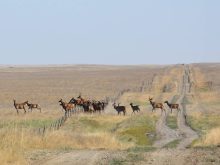EDMONTON – A $318 million aid program announced as spring seeding begins is designed to help Alberta farmers deal with high seeding costs, says the province’s agriculture minister.
“This program is to deal with rising input costs,” said Shirley McClellan.
She acknowledged the higher price of fertilizer and fuel will make it difficult for some farmers to break even this year.
“The program is designed to help, not to pay, your input costs.”
The federal-provincial cost-shared program will pay farmers $10.29 per cultivated acre. It will be paid on land farmed in 2000 and will go to farmers who actively farmed the land during this period.
Read Also

Crop quality looks good this year across Prairies
Crop quality looks real good this year, with the exception of durum.
The federal government’s portion of the program is $126.8 million and the province will pay $191.2 million.
Traditionally the federal government pays 60 percent of the cost-shared programs and the province pays 40 percent, but the ratio is reversed in this Canada-Alberta Farm Income Assistance Program.
Some new money
The provincial money is a combination of new funds and reallocated funds in the existing budget. The federal money is part of the $500 million aid package announced earlier this spring.
“Farmers have told us clearly they don’t want to exist on subsidies. But when it’s outward forces they can’t control, then maybe we have to step in,” McClellan said.
“Is it enough? Probably not. But it’s what we can do.”
Rod Scarlett, executive director of Wild Rose Agricultural Producers, said the money will give a boost to rural communities, but it won’t save everyone.
“I think the minister was brutally honest. It’s not going to save anybody’s bacon.
“It may cover the increased cost of fertilizer. It may not even cover that,” said Scarlett. The province needs to look at long-term solutions to farmers’ income problems, he said.
McClellan said she’s looking for some solutions to come from the Ag Summit 2000, a series of meetings held across the province last year to come up with ideas.
The provincial Farm Income Assistance Program, designed to trigger money to farmers in years with lower income, doesn’t work after a series of years with low incomes. Plus, the farmer has to wait until the following year to qualify.
With an acreage payment, the money is available to farmers quickly.
“Farmers need the money today. This is a very fast way to turn the money around,” she said. “I think it’s going to help them. I think they’ll say it should have been more.”
















